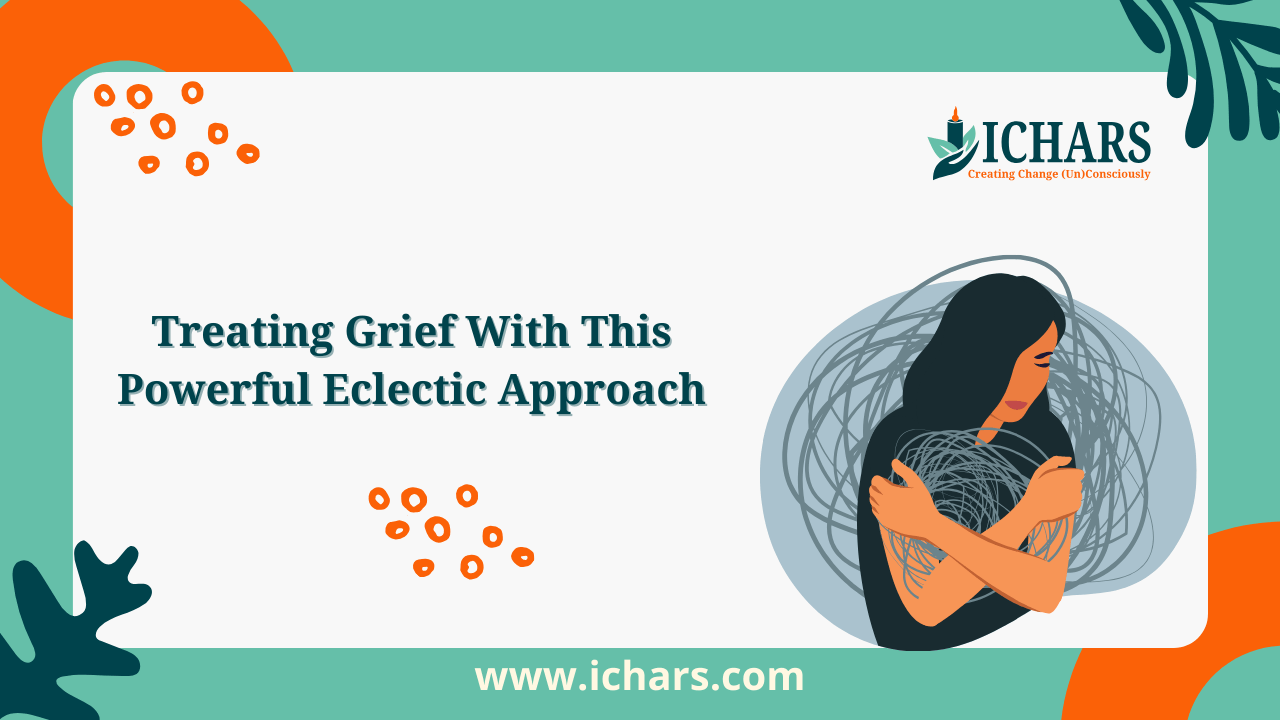Grieving is a natural and complex emotional response to loss, typically triggered by the death of a loved one, but it can also arise from other significant losses such as the end of a meaningful relationship, the loss of a job, or a major life change.
It involves a range of feelings, including sadness, sorrow, emptiness, and even anger. Grief is a universal human experience and can manifest both emotionally and physically. People may have trouble sleeping, eating, or concentrating, and they may experience physical symptoms like fatigue or aches.

What Is Grief Counselling?
Treating grief is not about trying to eliminate the pain of loss, as grief is a natural and necessary process. Instead, the goal of treatment is to help individuals cope with their grief, work through their emotions, and adapt to the loss in a healthy way.
Elements that may be involved in the treatment of grief
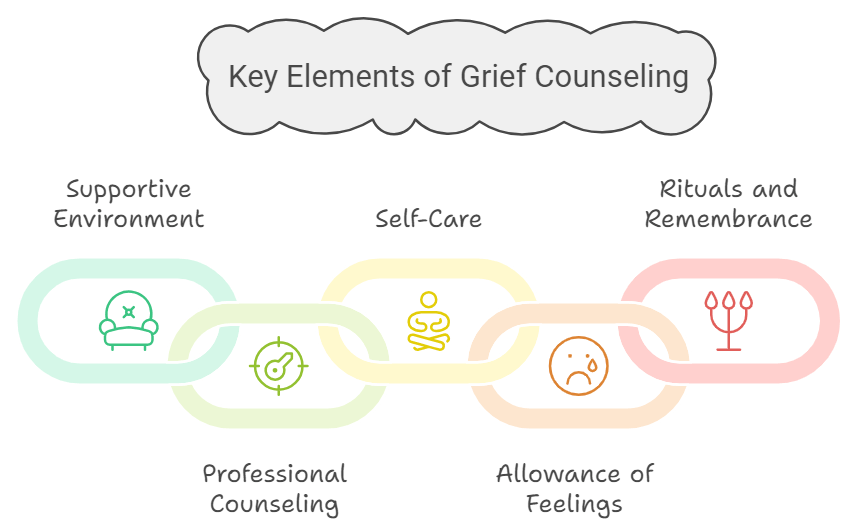
- Supportive Environment: It is crucial for individuals to have a supportive environment where they can express their feelings and be understood without judgment.
- Professional Counseling: Grief counseling, individual therapy, or support groups can provide a safe space for individuals to explore their emotions and receive guidance from trained professionals.
- Self-Care: Encouraging self-care practices such as exercise, proper nutrition, and sufficient rest can help manage the physical and emotional toll of grief.
- Allowance of Feelings: Acknowledging and allowing oneself to experience the full range of emotions that come with grief is essential. Suppressing or denying emotions can prolong the healing process.
- Time: Grief is a process that takes time. There is no specific timeline for healing, and individuals should allow themselves to grieve at their own pace.
- Rituals and Remembrance: Creating rituals or engaging in remembrance activities can be helpful in honouring the memory of the person or thing that was lost.
A study conducted by Maciejewski et al. (2016) titled “An Empirical Examination of the Stage Theory of Grief” published in JAMA Psychiatry investigated the grieving process and its stages in individuals who had lost a spouse.
The study found that grief did not follow a linear progression through predefined stages, as previously believed (such as the famous “Kübler-Ross model” with stages like denial, anger, bargaining, depression, and acceptance). Instead, individuals experienced grief in more complex and individualised ways. This study highlights the importance of personalised approaches to grief treatment and shows that there is no one-size-fits-all method for dealing with loss.
Overall, grief is a deeply personal experience, and the treatment approach should be tailored to the individual’s unique needs and circumstances. Professional help and supportive relationships can significantly aid in navigating the grieving process and finding ways to live with the loss while preserving the memory of what has been lost.
Signs of unprocessed grief

Most people can deal with the grief they experience after a significant loss. For some, the experience of distress is so extreme or prolonged that they seek the help of a professional grief counsellor (Worden, 2010).
Signs that one has not processed their grief and may benefit from grief counselling include:
- Prolonged and Intense Grief: If the individual’s grief is exceptionally intense and persists for an extended period, such as several months or even years, it may indicate that they are struggling to process their emotions effectively.
- Avoidance of Emotions: Difficulty in expressing or avoiding emotions related to the loss, either by bottling them up or engaging in distracting behaviours, can be a sign that the grief is not being processed.
- Disruption of Daily Life: If grief begins to interfere significantly with the individual’s ability to carry out daily tasks, work, or maintain relationships, it suggests that they might need additional support.
- Persistent Feelings of Guilt or Blame: If the person continually blames themselves or feels guilty about the loss, they may be stuck in a stage of grief that requires professional help to move forward.
- Isolation and Withdrawal: If the individual withdraws from social interactions, isolates themselves, or avoids talking about the loss, it can be an indication that they are struggling to cope with their grief.
Stages of Grief
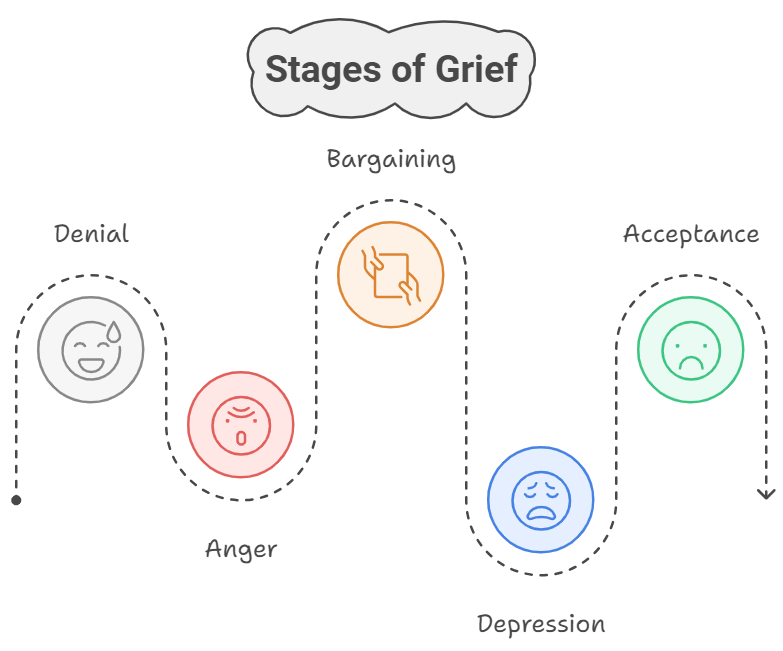
It’s important to note that these stages were originally proposed by Elisabeth Kübler-Ross in the context of terminally ill patients, and they have been widely popularised. However, it’s essential to understand that not everyone experiences these stages, and they may not occur in a linear or predictable order. Each person’s grief journey is unique, and not everyone will go through all these stages:

- Denial: In this initial stage, individuals may have difficulty accepting the reality of the loss. They might feel numb, in shock, or have a sense of disbelief.
- Anger: As reality sets in, individuals may feel anger and frustration, often directed at themselves, others, or even the deceased.
- Bargaining: During this stage, individuals may attempt to make deals or negotiate with a higher power to reverse or prevent the loss. They may experience guilt and think about what they could have done differently.
- Depression: In this stage, the full weight of the loss is felt, leading to feelings of deep sadness, emptiness, and hopelessness.
- Acceptance: This stage involves coming to terms with the loss and finding a way to live with it. It doesn’t mean that the pain disappears entirely, but rather that the person can find a new way of being in the world without the one they lost.
Again, it’s essential to emphasize that grief is a highly individualised experience, and not everyone will experience all of these stages or progress through them in a specific order.
Grief therapy and counselling can be beneficial in helping individuals navigate their unique grief journey and provide support to process their emotions in a healthy manner.
Goals of Grief Counselling
While grief can be associated with many forms of loss (including following a separation or divorce), here we focus on the processing related to bereavement. However, many of the concepts can be extrapolated to other aspects of living (American Psychological Association, 2022).
“The overall goal is to help the survivor adapt to the loss of a loved one and be able to adjust to a new reality without him or her” (Worden, 2010, p. 84).
It is helpful to highlight what psychologists and counsellors call the “four tasks of mourning.”
They facilitate adaptation to loss, involving confronting what has happened and restructuring thoughts, and include (Worden, 2010).
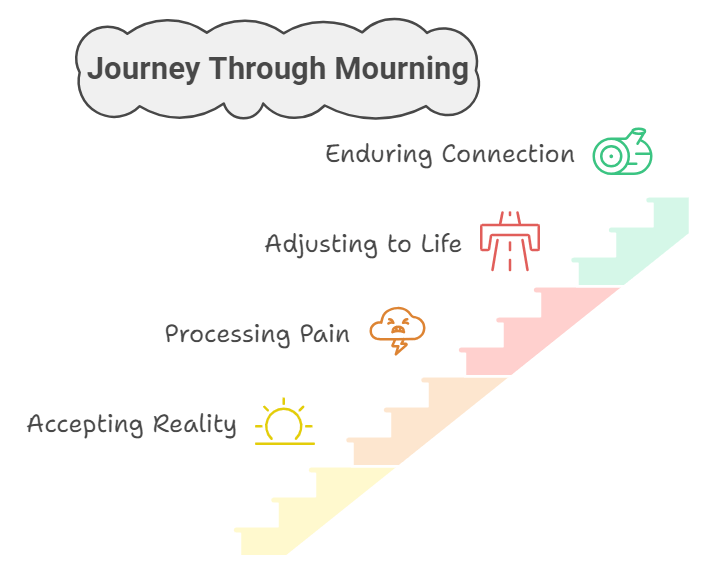
Four tasks of mourning
- Accepting the reality of loss
- Processing the pain of grief
- Adjusting to a world without the deceased
- Finding an enduring connection with the deceased while embarking on a new life
Subgoals of Grief Therapy/Counselling
The following subgoals of grief counselling are therefore aligned with each task (Worden, 2010)

Increasing the reality of loss
When someone experiences a major loss, such as the death of a loved one or the end of a meaningful relationship, it can be challenging to fully grasp the reality of that loss. This can be especially true in the early stages of grief when denial and disbelief may be prevalent.
As time passes and the individual begins to process their emotions, the reality of the loss gradually becomes clearer and more profound. They start to realise that the person or thing they lost is not coming back, and the permanence of the absence sets in. This process is often referred to as “increasing the reality of loss.”
Increasing the reality of loss can be a painful and challenging aspect of the grieving process. It involves confronting the emotional pain and accepting that life has changed permanently. It may lead to an intensification of grief and can be accompanied by feelings of sadness, anger, loneliness, and a profound sense of emptiness.
Grief counselling can be helpful during this stage as it provides a supportive and safe environment. Individuals can express their feelings, share their thoughts, and work through the pain of the loss.
Helping the individual deal with emotional and behavioural pain
Helping an individual deal with emotional and behavioural pain, especially in the context of grief or any significant loss, requires a compassionate and supportive approach. Here are some strategies that can be helpful:
- Active Listening: Be present and actively listen to the person’s feelings and thoughts without judgment. Let them express their emotions, memories, and concerns freely. Sometimes, simply having someone to talk to can be immensely comforting.
- Validate Their Feelings: Let the person know that their emotions are valid and understandable. Avoid minimising their pain or offering unsolicited advice. Instead, acknowledge their feelings and show empathy.
- Provide a Safe Space: Create a safe and non-threatening environment where the individual feels comfortable expressing themselves without fear of criticism or rejection.
- Encourage Emotional Expression: Encourage the person to express their emotions in healthy ways. This could include talking about their feelings, writing in a journal, or engaging in creative outlets like art or music.
- Be Patient: Grieving is a process that takes time, and everyone experiences it differently. Be patient with the person and allow them to go through their emotions at their own pace.
- Offer Practical Support: Help the individual with practical tasks or responsibilities that may be challenging for them during this time. This could include offering to cook a meal, run errands, or take care of other responsibilities.
- Suggest Professional Help: If the person’s emotional or behavioural pain becomes overwhelming or begins to significantly impact their daily life, encourage them to seek professional help, such as grief counseling or therapy.
- Avoid Imposing Timelines: Refrain from suggesting that the person should “get over” their grief within a specific timeframe. Grieving is a personal journey, and healing cannot be rushed.
- Foster Coping Mechanisms: Encourage the person to find healthy coping mechanisms that work for them, such as exercise, mindfulness practices, or spending time in nature.
- Respect Their Boundaries: Respect the person’s need for space and solitude if they require it. Grieving individuals may need time alone to process their emotions.
Remember that supporting someone through emotional and behavioural pain can be challenging, and it’s essential to take care of your well-being as well.
If you feel overwhelmed or unsure of how to help, consider seeking support from other friends, family members, or professionals. Together, you can provide a strong support system to help the grieving individual navigate their journey toward healing.
Supporting them as they overcome obstacles to readjustment
Supporting someone as they overcome obstacles to readjustment after a significant loss is a valuable and caring role. The process of readjustment following a loss can be difficult and may involve various challenges. Here are some ways you can provide support:
- Encourage Self-Compassion: Remind the individual that it’s okay to take their time and that healing is not linear. Encourage them to be patient and compassionate with themselves as they navigate the readjustment process.
- Offer Emotional Support: Continue to be a good listener and provide emotional support. Validate their feelings and let them know that you are there for them whenever they need to talk or express themselves.
- Help Identify and Set Realistic Goals: Assist the person in identifying small and achievable goals that can help them move forward. These goals could be related to daily routines, self-care practices, or personal interests they want to pursue.
- Provide Practical Assistance: Offer practical help with tasks or responsibilities that may feel overwhelming to them. This could include helping with household chores, childcare, or running errands.
- Promote Professional Help: Some people may struggle to readjust or face challenges that seem too difficult to manage. Encourage them to seek professional support, such as counselling or therapy.
- Offer Information and Resources: Provide information about support groups, workshops, or books that may be helpful in their healing journey. Knowledge about the grieving process and coping strategies can empower them.
- Respect Their Grieving Style: Recognize that each person grieves differently, and there is no one-size-fits-all approach to readjustment. Respect their unique process and choices during this time.
- Encourage Positive Coping Strategies: Support the individual in developing healthy coping mechanisms to manage stress and emotional pain. Engaging in activities like exercise, mindfulness, or spending time with supportive friends can be beneficial.
- Celebrate Progress: Acknowledge and celebrate their achievements, no matter how small they may seem. Each step toward readjustment is significant and should be acknowledged.
- Stay Connected: Continue to be present and available in the person’s life. Keep in touch regularly and check in on their well-being.
Remember that the readjustment process can be a rollercoaster of emotions, and the individual may experience setbacks along the way. Be a consistent and compassionate presence as they work through their obstacles and find a new way of living without what they have lost. Your support and understanding can make a significant difference in their healing journey.
Helping them find a way to maintain a bond while feeling comfortable reinvesting in life
Helping someone maintain a bond with what or who they have lost while also feeling comfortable reinvesting in life requires a delicate balance. It’s essential to validate the importance of the bond they had and acknowledge that moving forward doesn’t mean forgetting or abandoning the memory of what was lost. Here are some ways to support them in this process:
- Encourage Open Communication: Encourage the individual to express their feelings and memories of the person or thing they have lost. Create a safe and non-judgmental space for them to share their thoughts, stories, and emotions.
- Honour the Memory: Help them find ways to honour the memory of what they have lost. This could include creating rituals, dedicating time to reminiscing, or engaging in activities that hold significance to their bond.
- Support Their Grieving Journey: Recognise that grief is an ongoing process, and healing doesn’t mean letting go of the bond entirely. Be patient and supportive as they navigate the ebb and flow of their emotions.
- Encourage Self-Care: Help the individual prioritize self-care as they reinvest in life. Engaging in activities that bring them joy and nourish their well-being can create a sense of balance between the past and the present.
- Set Realistic Expectations: Understand that the process of maintaining a bond while reinvesting in life may take time. Set realistic expectations and avoid placing pressure on them to move on too quickly.
- Explore Supportive Groups: Suggest support groups or communities where individuals who have experienced similar losses can connect and share their experiences. Connecting with others who understand their journey can be comforting.
- Encourage New Experiences: Gently nudge them to try new experiences or pursue interests that they may have put on hold during their grieving process. Assure them that it’s okay to explore new opportunities while still cherishing the past.
- Be Patient with Grief Triggers: Understand that certain events, anniversaries, or places may trigger memories and emotions related to the loss. Be patient and supportive during these moments.
- Offer Practical Help: Provide practical assistance with tasks or responsibilities that may feel overwhelming, allowing them the time and space to process their emotions.
- Celebrate Their Progress: Acknowledge and celebrate any steps they take in reinvesting in life, no matter how small. Let them know that you are proud of their courage and resilience.
Remember that healing is a deeply personal journey, and everyone’s approach to maintaining a bond while moving forward will be unique. Be a supportive and understanding presence, and allow them to navigate their path at their own pace.
Grief Counselling and Grief Therapy: What’s the Difference?
While grief therapy and counselling may appear similar, Worden (2010) offers a helpful distinction.
“Counselling involves helping people facilitate uncomplicated, or normal, grief to a healthy adaptation to the tasks of mourning within a reasonable time frame” (Worden, 2010, p. 83).
On the other hand, grief therapy involves more specialised techniques associated with treating “people with abnormal or complicated grief reactions” (Worden, 2010, p. 83).
Grief support through therapy is often most appropriate when the reaction to grief is as follows (Worden, 2010):
- Complicated and prolonged
- Complicated and delayed
- Exaggerated
Complicated grief (or chronic grief) often involves the individual not accepting what has happened. They are left with long-term, intense sadness, anxiety, anger, guilt, and other emotions, interfering with their ability to reorient toward a new life (Brown, 2021).
Grief counselling: 3 techniques therapists can use
Understanding Grief, Mourning, and Bereavement
The terms grief, mourning, and bereavement are typically used interchangeably in everyday conversation and yet are sometimes distinguished as follows by mental health professionals (Worden, 2010, p. 17):
- Grief – the experience of losing someone to death (it can also include other losses)
- Mourning – the process the bereaved passes through to adapt and become accustomed to the death or loss
- Bereavement – the loss the individual feels while they learn to adapt to the new situation
Grief Therapy Techniques and Timing
Grief therapy must always be positioned to meet the needs of the bereaved. Loss is individual, specific, and not always experienced in the same way for everyone (Neimeyer, 2015).
Intervention can be made at any stage of grief, depending on the individual’s needs and circumstances. There is no specific timing that dictates when intervention should occur. However, offering support and intervention early on can be beneficial in helping the individual navigate the initial shock and overwhelming emotions that often accompany the early stages of grief.
Overall, the timing of intervention in grief support depends on the individual’s needs and the availability of support resources. Early intervention can be helpful in providing comfort and guidance during the initial stages of grief, but support should be ongoing and available throughout the grieving process as needed.
Whether death is expected or the result of trauma, putting loved ones in a state of extreme shock, the first 24 hours are a whirlwind of emotions. That initial time also includes meeting and communicating with family and friends about what has happened and beginning to think about the funeral arrangements.
The individual may not fully accept or feel ready to come to terms with the unfolding events and find themselves caught up in intense grief and confusion (Worden, 2010).
When death is expected, family members may contact a therapist before the loss. However, on many occasions, it is an afterthought and the result of an inability to cope.
11 Powerful Techniques for Grief Counselling Using the Eclectic Approach Through Cognitive Hypnotic Coaching and Psychotherapy
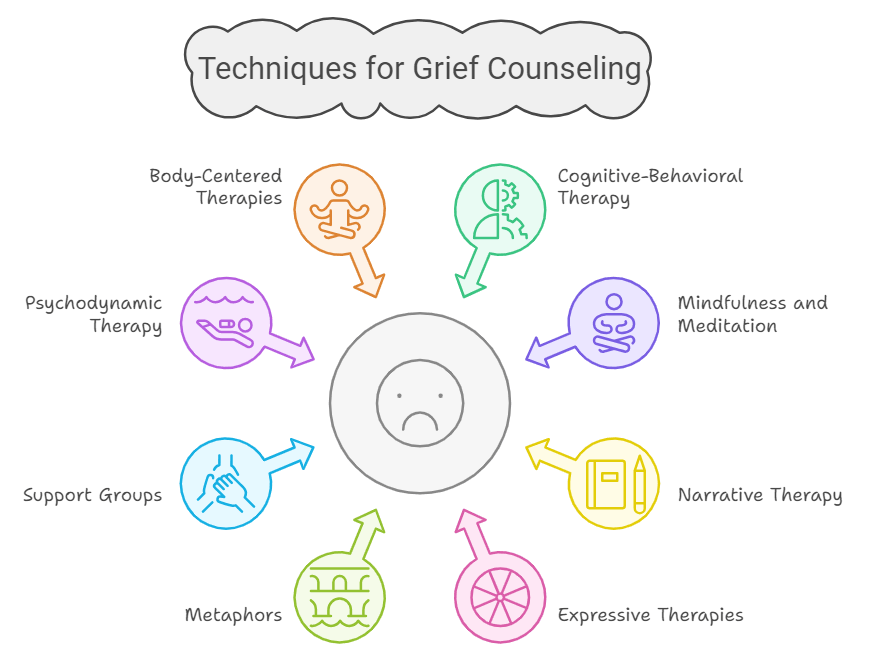
The eclectic approach in counselling and psychotherapy refers to a flexible and integrative therapeutic approach that draws from multiple theoretical perspectives and techniques. Instead of adhering strictly to a single theoretical model, therapists using the eclectic approach tailor their interventions to meet the individual needs and preferences of their clients. This approach allows therapists to combine elements from various therapeutic theories to create a customized and comprehensive treatment plan.
Here are some elements that might be incorporated into a powerful eclectic approach to treating grief:

- Cognitive-Behavioural Therapy (CBT): CBT can help individuals identify and change negative thought patterns and behaviours associated with grief. It can also assist in developing coping strategies to manage overwhelming emotions and promote healthier ways of processing grief.
- Mindfulness and Meditation: Mindfulness practices can help individuals become more aware of their emotions and thoughts in the present moment without judgment. Meditation can provide a sense of calm and aid in processing grief.
- Narrative Therapy: This approach focuses on constructing and understanding one’s personal narrative surrounding the loss. By exploring and reshaping the story of the loss, individuals may find healing and new perspectives.
- Expressive Therapies: Art therapy, music therapy, and other forms of expressive therapies can offer nonverbal outlets for processing emotions and grief. Creative expression can be a powerful tool for healing. Creating pictures and artwork can facilitate feelings, increasing awareness of the loss and identifying where the individual is in their mourning.
- Metaphors
Using metaphors in grief counseling is a surprisingly powerful approach. It helps lower resistance to the pain of bereavement when patients cannot directly confront feelings surrounding the death. (Worden, 2010, p. 107) - Support Groups: Being part of a grief support group can create a sense of belonging and understanding among individuals who have experienced similar losses. Sharing experiences and emotions with others can be validating and comforting.
- Psychodynamic Therapy: This therapeutic approach can help individuals explore and process underlying emotions and unresolved issues related to the loss.
- Body-Centered Therapies: Techniques like yoga, tai chi, or somatic experiencing can help release physical tension and emotional stress stored in the body.
- Positive Psychology: This approach can assist in finding sources of hope, gratitude, and positive meaning even amidst grief.
- Grief Rituals and Symbolism: Incorporating rituals or symbolic actions to honor the deceased can help in the mourning process and provide closure.
- Family Systems Therapy: Grief can impact family dynamics significantly, and this approach can address how grief is experienced and processed within the family unit.
Remember that everyone grieves differently, and there is no one-size-fits-all approach. An eclectic approach allows the therapist to tailor the treatment to the individual’s unique needs and preferences. Seeking professional support from a trained therapist or counselor experienced in grief counselling can make a significant difference in the healing process.
While therapy must be grounded on a solid understanding of the individual and their personal and behavioural needs, the following techniques have proven helpful to many clients facing bereavement.
Summary
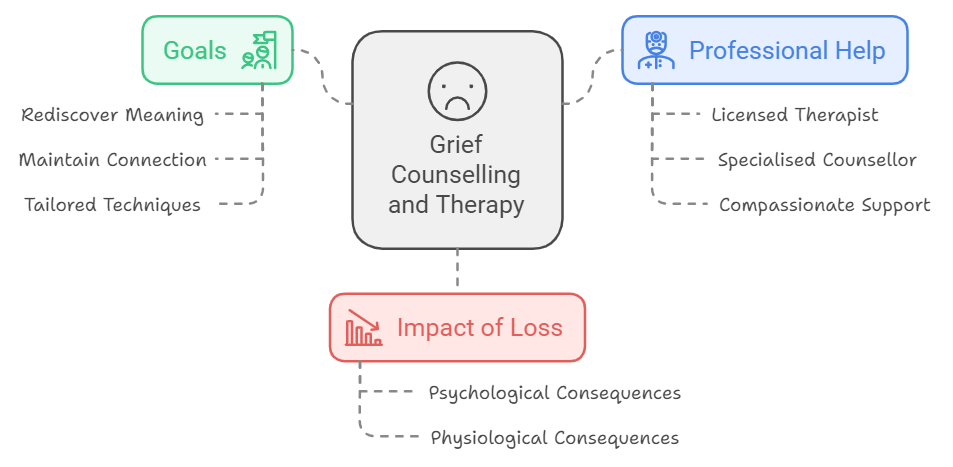
In some cases, the impact of loss can have long-lasting psychological and physiological consequences that can be difficult to return from.
While distinct in their focus, grief counselling and grief therapy seek to guide clients through their bereavement. The ultimate aim is to help clients rediscover meaning in life while maintaining a connection to their lost loved one.
The key to success in either approach is tailoring the techniques, timing, and setting to the individual’s unique needs. There is no one-size-fits-all solution for navigating the complexities of grief. Instead, the therapist should adapt tools and interventions to suit the client’s specific circumstances.
When it comes to Grief, it is essential to seek professional help from a licensed therapist or counsellor who specialises in grief counselling. Combined with the compassionate support of a grief counsellor or therapist, all of these can prove beneficial in supporting a grieving client.
References
- American Psychological Association. (2022, August). Grief. Retrieved April 4, 2023, from https://www.apa.org/topics/grief.
- Neimeyer, R. A. (2015). Techniques of grief therapy: Creative practices for counseling the bereaved. Routledge.
- Worden, J. W. (2010). Grief counselling and grief therapy: A handbook for the mental health practitioner. Routledge. Brown, B. (2021). Atlas of the heart. Vermilion.
